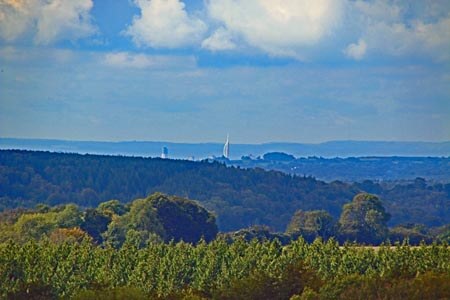Uppark House and Garden

Uppark House is located on the B2146 just south of South Harting in West Sussex, approximately 17 miles from Portsmouth, a 17th century house it is a National Trust property.
Uppark House, located near South Harting, Hampshire, is a fine example of a Georgian country house with a rich and varied history. It was built in the late 17th century, around 1690, for Ford Grey, the 1st Earl of Tankerville. The house is positioned on the South Downs, offering stunning views of the surrounding countryside. Its architectural style is classic for the period, featuring elegant proportions and refined interiors.
In 1747, the estate was purchased by Sir Matthew Fetherstonhaugh, who, along with his wife Sarah, extensively redecorated and refurnished the house in the mid-18th century, incorporating a significant collection of art and antiques from their Grand Tour of Europe. Their only son, Sir Harry Fetherstonhaugh, inherited the estate and made various changes to both the house and the gardens, reflecting his flamboyant lifestyle. Sir Harry was known for his extravagant parties and eccentric personality.
In 1825, at the age of 71, Sir Harry married his 21-year-old dairymaid, Mary Ann Bullock, which caused a scandal in society due to their difference in social status and age. Mary Ann, however, proved to be an effective manager of the estate and significantly contributed to its preservation. After Sir Harry's death in 1846, Mary Ann continued to live at Uppark until her own death in 1874.
The estate eventually passed to Lt. Col. Herbert Meade-Fetherstonhaugh, a nephew of Sir Harry, who made efforts to maintain the property. In 1954, Uppark was bequeathed to the National Trust by his widow, Meade Fetherstonhaugh, ensuring its protection and public access.
A significant event in the house’s recent history occurred in 1989 when a catastrophic fire severely damaged the building. The fire destroyed the roof and much of the upper floors but, thanks to the quick removal of many valuable items by staff and volunteers, much of the collection was saved. The National Trust undertook an extensive and meticulous restoration, which lasted six years and restored Uppark to its former glory, reopening to the public in 1995.
Today, Uppark House stands as a testament to the resilience of heritage conservation, showcasing not only the elegance of Georgian architecture but also the fascinating stories of the people who lived there. It remains a popular destination for those interested in English history, architecture, and the preservation of historic estates.
Uppark House Gardens
The gardens at Uppark House are a harmonious blend of historical design and natural beauty, set against the stunning backdrop of the South Downs. Originally laid out in a formal style, they were reimagined in the mid-18th century by Sir Matthew Fetherstonhaugh and his wife Sarah, who embraced the naturalistic landscape trend of the time. This transformation created sweeping lawns, strategically placed trees, and picturesque views.
Key features include the Georgian pleasure grounds with winding paths, the South Lawn offering expansive views, and the charming walled garden, historically used for growing fruits and vegetables. The surrounding woodlands add a serene, shaded contrast, making the gardens a tranquil and visually captivating extension of the estate, reflecting its rich heritage through the changing seasons.

